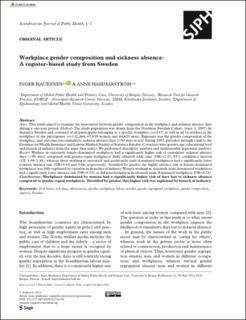| dc.contributor.author | Haukenes, Inger | |
| dc.contributor.author | Hammarström, Anne | |
| dc.date.accessioned | 2023-10-03T12:32:06Z | |
| dc.date.available | 2023-10-03T12:32:06Z | |
| dc.date.created | 2023-07-10T12:30:09Z | |
| dc.date.issued | 2023 | |
| dc.identifier.citation | Scandinavian Journal of Public Health. 2023, . | en_US |
| dc.identifier.issn | 1403-4948 | |
| dc.identifier.uri | https://hdl.handle.net/11250/3093807 | |
| dc.description.abstract | Aims: This study aimed to examine the association between gender composition in the workplace and sickness absence days during a one-year period. Methods The study population was drawn from the Northern Swedish Cohort (wave 3; 2007) by Statistics Sweden and consisted of all participants belonging to a specific workplace (n=837) as well as all co-workers at the workplace of the participants (n=132,464; 67,839 women and 64,625 men). Exposure was the gender composition of the workplace, and outcome was cumulative sickness absence days (⩾90 days or not) during 2007, provided through a link to the Database for Health Insurance and Labour Marked Studies of Statistics Sweden. Covariates were gender, age, educational level and branch of industry from the same data source. We performed descriptive analyses and multivariable regression analyses. Results: Workers in extremely female-dominated workplaces had a significantly higher risk of cumulative sickness absence days (⩾90 days) compared with gender-equal workplaces (fully adjusted odds ratio (OR)=1.27; 95% confidence interval (CI) 1.09–1.48), whereas those working in extremely and moderately male-dominated workplaces had a significantly lower sickness absence risk (OR=0.62 and 0.66, respectively). Stratified by gender, the higher absence risk at female-dominated workplaces was fully explained by variation in branches of industry. Women working in extremely male-dominated workplaces had a significantly lower absence risk (OR=0.75), as did men working in moderately male-dominated workplaces (OR=0.78). Conclusions: Workplaces dominated by women had a significantly higher risk of days lost to sickness absence compared to gender-equal workplaces. Stratified by gender, this higher risk was explained by branch of industry | en_US |
| dc.language.iso | eng | en_US |
| dc.rights | Navngivelse 4.0 Internasjonal | * |
| dc.rights.uri | http://creativecommons.org/licenses/by/4.0/deed.no | * |
| dc.title | Workplace gender composition and sickness absence: A register-based study from Sweden | en_US |
| dc.title.alternative | Workplace gender composition and sickness absence: A register-based study from Sweden | en_US |
| dc.type | Peer reviewed | en_US |
| dc.type | Journal article | en_US |
| dc.rights.holder | © Author(s) 2023 | en_US |
| dc.description.version | publishedVersion | en_US |
| cristin.ispublished | true | |
| cristin.fulltext | original | |
| cristin.qualitycode | 1 | |
| dc.identifier.doi | 10.1177/14034948231176108 | |
| dc.identifier.cristin | 2161665 | |
| dc.source.journal | Scandinavian Journal of Public Health | en_US |
| dc.source.pagenumber | 7 | en_US |

